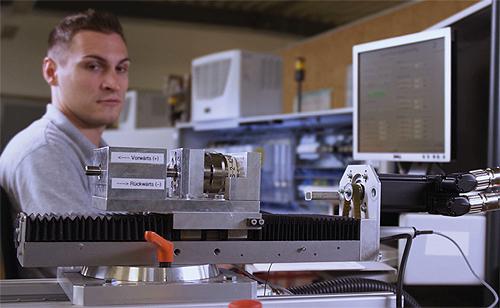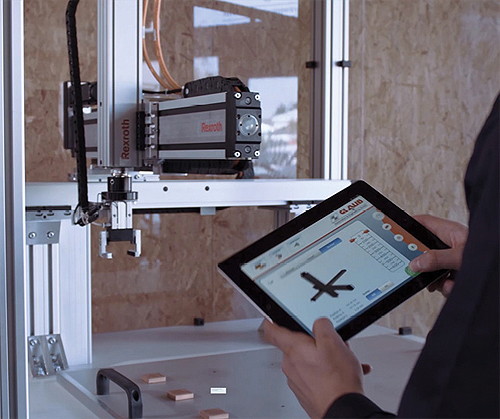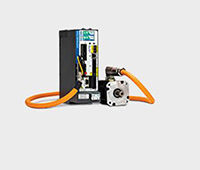Edited by Mary Gannon/Senior Editor
Automation systems and motion control systems are constantly becoming more complex. So it can be a breath of fresh air to find a tool to program and control them that is simple and easy to use. That is why Bosch Rexroth created its new Open Core Engineering software portfolio for use with a variety of programming languages and even with an everyday smart phone.
By bringing together the worlds of automation and IT, the Open Core Interface (OCI) automatically makes a variety of programming languages available to the control unit. This means machinery manufacturers can program with modern higher-level languages without having to write a single line of PLC code, thus reducing programming efforts by up to 50%.

For machine manufacturers who program their operating and diagnostic surfaces as “apps” in a programming environment, the Open Core Interface ensures that machine control understands and carries out the orders of these application programs directly.
This software connects the previously separate PLC and IT worlds by offering an integrated solution consisting of open standards, software tools, function toolkits, and the OCI. With a variety of high-level languages and operating systems, machinery manufacturers can create independent individual functions that run parallel to the firmware directly on the control unit or on external devices. For example, with this capability, machinery manufacturers can fully integrate smart devices into automation and take advantage of their operational interface capabilities.
How it works
Say a machine designer needs to know the life cycle of a component and how much stress it can withstand. He or she needs to use special measuring and testing machines, often programmed with LabVIEW software from National Instruments. However, in addition to LabVIEW, machine manufacturers must program machine controls and coordinate the two programs with one another. There are no standard interfaces for this, so extra programming hours were required as the respective programs were written and tested to see if they were compatible in operation.
With OCI, however, the work of programmers has been simplified and the time required often cut in half. Now, a programmer uses LabVIEW to produce the software for the tests and the movement processes of the machine without needing to write a single line of PLC code. This eliminates double work and error-prone interface programming. Rexroth is providing libraries with more than 550 virtual instruments. They “translate” the LabVIEW commands for the PLC controls.
Machinery manufacturer Kraus Automatisierungstechnik GmbH, Hassfurt, Germany, is already using OCI to its benefit, to reduce engineering efforts and to reduce delivery times. With the same team, the company can now program twice as many machines.

Through the use of Bosch Rexroth’s Open Core interface, Glaub Automation has simplified the design of axles by using the tilt function on a tablet device rather than entering data manually.
Complicated devices need not apply
Smart phones and tablets have advanced to the point that they can be used not only for playing games and posting to social media but also for designing and operating automation systems. Instead of industrial terminals and displays, machine designers can use their smart devices for commissioning, diagnosis, and operation, thanks to Open Core Engineering and Open Core Interface.
The ease offered by swiping a touch screen is in high demand with machine operators because it reduces their training efforts considerably, Rexroth said. OCI allows machine manufacturers to program their operating and diagnostic surfaces as “apps” in a programming environment on the smart devices’ operating systems. It ensures that machine control understands and carries out the orders of these application programs directly. No programming of the controls is necessary. This would not be possible in the past, as the controls typical in today’s market only understand programming languages of the world of automation.
The first apps for commissioning and operating machines show how creatively smart devices are at facilitating the approach to machine functions. For example, Glaub Automation uses the acceleration sensors of tablet PCs to program axle movements. Previously, when a commissioning engineer wanted to move an axle, he had to enter a number of data: the distance, the terminal position, the acceleration, the maximum speed, and the braking before the terminal position. In the app developed by Glaub Automation, the operator sets his two thumbs onto two stylized fingerprints on the display of the tablet PCs. Then, he tilts the device to the side and the axle moves. The stronger the tilt, the stronger the drive accelerates. As soon as a thumb releases the fingerprints, the axle stops. In other apps, the commissioning engineer moves the controller on the display to determine the acceleration.
The diagnosis of machinery is also becoming considerably faster and simpler through the use of smart devices. Maintenance technicians can—with authorization—dial into different machines in sequence using wireless technology. They retrieve all diagnosis data with one user interface from any location. Navigation occurs through the swipe of a finger. In the case of an error, they can even change parameters and then fix a machine stop.
Bosch Rexroth Corp.
www.boschrexroth-us.com
Filed Under: Factory automation, MOTION CONTROL, MORE INDUSTRIES, PLCs + PACs





I still don’t understand what they do to make Labview control the PLC. Why the movement of that machine need PLC? I guess that the motion control is not accurate at all via control (by PLC). Isn’t that better(more accurate and cheaper) to use a specific embedded system designed to control the movement? What kind of PLCs can be used with the mentioned additional library?